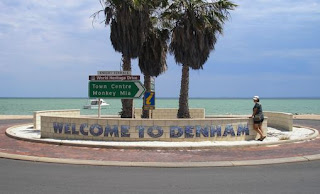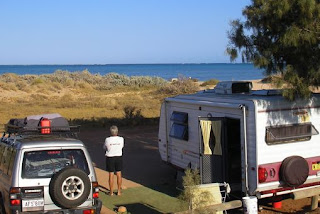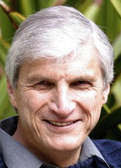
The boot was on the other foot, or rather, the microphone in another’s hand when a French TV documentary crew met the Dique Trippers.
Lunch with Roland Theron (right) and his cameraman Nicolas under our awning.
Roland Theron of Les Nouveaux Explorateurs is making a documentary on interesting and unusual Australian houses.
He felt his documentary would not be complete without a glimpse into the life of a ‘grey nomad’.

After shooting a piece on living underground in Coober Pedy, he was due to fly back to France via Alice Springs and Perth.
Prevelly Beach near Margaret River.
Marie Cortez, a former work colleague of mine, and part of the local French network, knew we were in WA and put him in touch with us.
We met at our van at Prevelly Beach, near Margaret River. Roland and his cameraman Nicolas kindly brought the makings for lunch.

In my last job I did video interviews with business leaders for posting on the web, so it felt a bit strange to have a camera pointed at me for a change.
Wildflowers, part of the coastal heath at Prevelly Beach.
Cooking up a story
In actual fact the star of the show was Carol, who not only answered the big questions, but was also closely videoed cooking lunch, in this case a tasty cheese omelette.
The best I could do was supply a bottle of local shiraz. Roland seemed unimpressed by the screw top instead of cork stopper, but I think he found the wine OK.

To sum up, we found Roland and Nicolas (who pointed his camera at every nook and cranny of our van, including the untidy bits) most engaging and charming, and we all had an enjoyable lunch.
Gardens at Walcliffe House on the Margaret River.
We finished off the day exploring a nearby mansion, Walcliffe House and its beautiful gardens on the Margaret River, where funds were being raised for the local fire service.
You can check out the people Roland interviewed at this site.
Out of the frying pan and into the fridge!

It’s amazing what a difference a few hundred kilometres can make.
After leaving Geraldton, the heat and continuous sunshine, we decided to bypass Perth, stay awhile at Margaret River and explore WA’s south western region before heading back to Perth.
Gale force winds knocked down this large tree, which narrowly missed an onsite van across from us.
We couldn’t believe the winds, the rainsqualls and the cold that greeted us! At night, where once we would sleep with barely a sheet over us, we found ourselves under blankets, doona and quilt. Outside it was colder than a witch's tit.
The wind was so strong it brought down a large tree that narrowly missed an on-site van.
Our Indian summer was well and truly over.
Having said that we bravely did get in some long walks, and found the coastal heath spectacular, with its purple, yellow, white and pink wildflowers.
We also managed to sneak in a game of golf.
Cruel Cape Leeuwin

A long-felt ambition has been to visit Cape Leeuwin, the extreme south west point of WA, where the Indian Ocean meets the Southern Ocean.
Hamelin Beach, en route to Augusta and Cape Leeuwin.
The place is named after the Dutch ship Leeuwin (Lioness) that rounded the cape in 1622.

It’s also where the great navigator Matthew Flinders commenced his circumnavigation of Terra Australis (Australia) in the Investigator on 7 December, 1801.
Cape Leeuwin lighthouse.
So down we went. It was blowing a gale when we arrived 50 kilometres later at the Cape Leeuwin Lighthouse, with continuous cold rainsqualls.

Carol wrapped herself in a blanket but took only 10 steps before returning to the car, collecting a refund of her entry fee on the way.
Forbidding Cape Leeuwin, where the Indian Ocean meets the Southern Ocean.
I don’t blame her. Spectacular though it may be, the Western Australian coast can be hostile and unforgiving.
Drenched and cold, I could see from the lighthouse (opened in 1896) the rocks, reefs and angry sea that made its construction essential.
After a perfunctory drive around the sleepy hamlet of Augusta, we headed back to Margaret River.
Where there’s a wine, there’s a way

Of course, we also managed to do a bit of wine tasting – how could we visit Margaret River and not do so!
I have to mention there’s currently a glut of wine making it immensely affordable.
At the Vasse Felix winery.
The problem I have with wine tasting is that I always feel compelled to buy a bottle of whatever I’ve liked (which is all of it), and usually come away loaded up with more than we really need or can stow.
Despite prodding from Carol on site to abandon this practice, our van toilet is now sharing space with a carton of shiraz, while bottles of semillon blanc, port and other delightful nectars have been forced into nooks and crevices that we never knew existed.
A Quick visit

Believe it or not, one of Carol’s distant relatives lives just five minutes drive from our van park at Prevelly Beach.
I refer to Gabrielle Adams, sister of well-known Brisbane based TV cameraman Paul Adams who is married to Carol’s niece Madonna.
Gabrielle, Molly, Carol and Kelsey (plus pet rats Olympia and Smash).
We called in to see Gabrielle, Molly and Kelsey (and their pet rats Olympia and Smash) -- unfortunately partner Tim Quick was away in Perth.

Over a cup of tea Gabrielle told how they had to evacuate their home two weeks ago when a bushfire threatened the area.
Burned out coastal heathland near Gabrielle's home.
The fire came quite close, but their home was saved.
And here we are in the midst of wind, rain and chill, hoping and praying for fine weather.
But, as my mother used to say, if wishers were horses beggars would ride!
It’s time to work our way down to Albany and then back to Perth regardless of the weather.



































